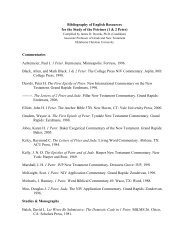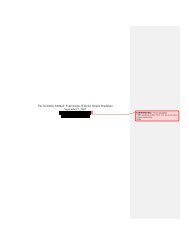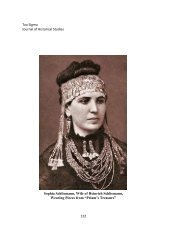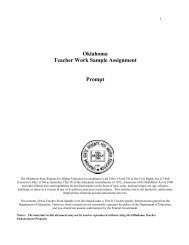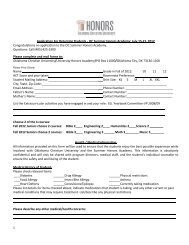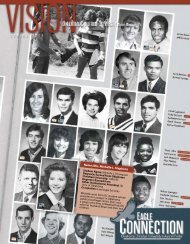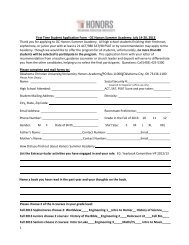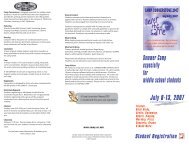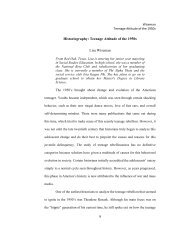DSP II: ELEC 4523 Real-Time Data Exchange - Faculty
DSP II: ELEC 4523 Real-Time Data Exchange - Faculty
DSP II: ELEC 4523 Real-Time Data Exchange - Faculty
You also want an ePaper? Increase the reach of your titles
YUMPU automatically turns print PDFs into web optimized ePapers that Google loves.
Objectives<strong>DSP</strong> <strong>II</strong>: <strong>ELEC</strong> <strong>4523</strong><strong>Real</strong>-<strong>Time</strong> <strong>Data</strong> <strong>Exchange</strong>• In this laboratory you will become familiar with <strong>Real</strong>-<strong>Time</strong> <strong>Data</strong> <strong>Exchange</strong> (RTDX) and itsuse with Visual Basic (VB) to transfer data between the target <strong>DSP</strong> and the host computer.Reading• SPRU423 TMS320 <strong>DSP</strong>/BIOS Users Guide: <strong>Real</strong>-<strong>Time</strong> <strong>Data</strong> <strong>Exchange</strong> (section)• Code Composer Studio Online Help: RTDX• Code Composer Studio Online Tutorials: RTDX• Websites dedicated to Visual Basic (VB)• http://www.vbsquare.com/• http://www.vbtutor.net/• http://www.vbexplorer.com/VBExplorer/VBExplorer.asp• http://webspace.dialnet.com/paul_pbcoms/vb/tutor.htmlLab Module PrerequisitesYou should go through one of the tutorials available on the internet or read an introduction toVB book before starting this lab.DescriptionRTDXRTDX allows <strong>DSP</strong> programs to transfer data between the <strong>DSP</strong> device and a host computerwithout affecting the <strong>DSP</strong> application. There are components on the <strong>DSP</strong> device (target) and thehost computer that allow this communication to take place. This section will describe the RTDXon the target and the next section will describe the component on the host that is used with VB.RTDX is very flexible and has many features, but only a few will be described here.Figure 1 shows the data flow between the target and the host. When transferring data fromthe target to the host an output channel is first opened on the host. <strong>Data</strong> is written to this channelwhich causes the data to be written to a buffer set up by the RTDX target library. This buffer isthen sent to the host by the RTDX library over the JTAB interface. On the host computer thedata is received and either written to a buffer in memory or written to a log file. A hostapplication can then use the data in the buffer using the RTDX host library calls.To send data from the host to the target, the target must open an input channel. The targetrequests data from the input channel and the RTDX target library sends a request over the JTAGinterface to the host library. Once the host application has written data to the host buffer theRTDX host library will send data to the target over the JTAG interface.
<strong>Real</strong>-<strong>Time</strong> <strong>Data</strong> <strong>Exchange</strong> Page 2/10Figure 1: RTDX <strong>Data</strong> Flow between Host and Target, taken from SPRU423 TMS320 <strong>DSP</strong>/BIOS Users GuideThere are two modes for RTDX to receive data from the target application:• Continuous mode - In this mode the data is written to a buffer only and continuously writtento the target application. Use this mode if you want to continuously send and receive data oryou don’t need to save data to a log file.• Non-continuous mode - In this mode data is written to the log file on the host. This shouldbe used to write a finite amount of data to the log file.To configure RTDX open the RTDX Configuration Tool by selecting Tools->RTDX->Configuration Control. This will open a window that shows the current settings for RTDX.NOTE: RTDX will not work unless it is enabled by putting a check mark next to EnableRTDX. This must be done before running any RTDX application. To change the settingsmake sure the RTDX is disabled, right click on the window and select Property Page. Here themode can be selected and the size of the buffers determined.The steps that need to take place in the target application to send or receive data from thehost are given below.• Include the RTDX header file rtdx.h.• Declare a global input or output channel for receiving or sending data. The channels are datastructures that are declared with the following macros. The channel name is input to themacro and can be any name.RTDX_CreateInputChannel( name );RTDX_CreateOutputChannel( name );• Initialize the target. There are a couple of things that must be initialized on the target. Ifusing the <strong>DSP</strong>/BIOS configuration tool these will both occur automatically. However, thesecond item will only occur after the main function has exited.• One thing that must be done is the target application must periodically call the functionRTDX_poll to keep the data flowing between the host and target. If the configurationtool is used it sets this up for you. The HWI HWI_RESERVED1 is used to call thefunction RTDX_poll on a periodic basis.• On the ’C6x RTDX uses interrupts. Therefore the NMI and global interrupts must beenabled.• Enable the channel for reading or writing using one of the following functions.RTDX_enableInputRTDX_enableOutput• Read or write the RTDX channel using one of the following function. The functionRTDX_read is a blocking read function and the function RTDX_readNB is a non-blocking
<strong>Real</strong>-<strong>Time</strong> <strong>Data</strong> <strong>Exchange</strong> Page 3/10read function. The RTDX_read function actually waits in a loop for the read to becompleted. It will not cause a task to enter the TSK_BLOCKED state.RTDX_readRTDX_readNBRTDX_write• Disable the channel after use. The functions to disable either an input or output channel aregiven below.RTDX_disableInputRTDX_disableOutputThis process is shown in the following code section where an SWI is set up to output data tothe host. In this example a single integer is sent to the host one time. Examine the code sectionan compare to the steps outlined above. This example assumes that the configuration tool is usedto set up <strong>DSP</strong>/BIOS and therefore the target does not need to be initialized./* create a global output channel */RTDX_CreateOutputChannel( ochan );void funSWI(){int data = 10; /* data to send to host */int status;/* enable the output channel */RTDX_enableOutput( &ochan );/* send the data to the host */status = RTDX_write( &ochan, &data, sizeof(data) );/* check the status of the write operation */if ( status == 0 ) {puts("ERROR: RTDX_write failed!\n" );exit(-1 );}}/* disable the channel after use */RTDX_disableOutput( &ochan );The next section of code shows a similar SWI set up to input an integer from the host.Notice that the structure of the code is the same as the above section of code./* create a global input channel */RTDX_CreateInputChannel( ichan );void funSWI(){int data;int status;/* enable the input channel */RTDX_enableInput( &ichan );/* send the data to the host */
<strong>Real</strong>-<strong>Time</strong> <strong>Data</strong> <strong>Exchange</strong> Page 4/10status = RTDX_read( &ichan, &data, sizeof(data) );/* check the status of the read operation */if ( status != sizeof(data) ) {puts("ERROR: RTDX_read failed!\n" );exit(-1 );}/* use the value of the read data here */}/* disable the channel after use */RTDX_disableInput( &ichan );There are a few more functions in the RTDX module.• RTDX_sizeofinput is designed to be used in conjunction with RTDX_readNB after aread operation has completed. The function returns the number of sizeof units actually readfrom the specified data channel.• RTDX_channelBusy is also designed to be used in conjunction with RTDX_readNB. Thereturn value indicates whether the specified data channel is currently in use or not.• RTDX_isInputEnabled and RTDX_isOutputEnabled test whether a channel hasbeen enabled.Visual BasicThis laboratory will not show you how to program in VB. There are many tutorials on theinternet and many books available to learn VB. It is assumed that you have gone through atutorial on using VB before starting this lab. Descriptions of VB were written for Visual Basic6.0.VB Host Application BasicsThe steps that need to take place in the host application to send or receive data from thetarget are given below.• Define and include the RTDX return code constants. Some functions return statusinformation and the following codes can be used to evaluate that information.Const Success = &H0’ Method call is validConst Failure = &H80004005 ’ Method call failedConst ENo<strong>Data</strong>Available = &H8003001E ’ No data was available.’ However, more data may be’ available in the futureConst EEndOfLogFile = &H80030002 ’ No data was available.’ The end of the log file has’ been reached.• Declare a variable of type Object.Dim rtdx As Object• Create an instance of the RTDX COM object.Set rtdx = CreateObject("RTDX")• Open a channel for reading or writing where rtdx is the object that was opened.status = rtdx.Open("ochan", "R")status = rtdx.Open("ichan", "W")• Read or write data from the channel.
<strong>Real</strong>-<strong>Time</strong> <strong>Data</strong> <strong>Exchange</strong> Page 5/10• ReadSAI1, ReadSAI2, ReadSAI4, ReadSAF4, ReadSAF8, ReadSAI2V,ReadSAI4V, Read - Read a message and put the result in a VB SAFEARRAY• ReadI1, ReadI2, ReadI4, ReadF4, ReadF8 - read integer or floating-point datafrom the data channel.• Write - Write data from a SAFEARRAY to the host.• WriteI1, WriteI2, WriteI4, WriteF4, WriteF8 - Write data to the target.• Close the channel from reading or writing where rtdx is the object that was opened.status = rtdx.Close()• Release the reference to the RTDX COM object where rtdx is the object that was opened.Set rtdx = NothingThe following code is a host application that inputs one integer at a time. In the loop thechannel is read and the status returned is checked to determine the result of the read.Const Success = &H0Const Failure = &H80004005Const ENo<strong>Data</strong>Available = &H8003001EConst EEndOfLogFile = &H80030002’ Method call is valid’ Method call failed’ No data was available.’ However, more data may be’ available in the future.’ No data was available’ The end of the log file has’ been reached.Sub main()Dim rtdx As ObjectDim data As LongDim status As Long’COM object’If an error occurs then go to the following functionOn Error GoTo Error_Handler’Create the COM objectSet rtdx = CreateObject("RTDX")’Open the COM objectstatus = rtdx.Open("ochan", "R")’Check the status of the open functionIf status Success ThenDebug.Print "Opening of channel ochan failed"GoTo Error_HandlerEnd IfDo’Read an integer from the RTDX input channelstatus = rtdx.ReadI4(data)’Check the status of the readSelect Case (status)Case SuccessDebug.Print "Value " & data & " was received from the target"Case ENo<strong>Data</strong>AvailableCase EEndOfLogFileDebug.Print "End of log file has been detected"Case FailureDebug.Print "ReadI4 returned failure"Exit Do
<strong>Real</strong>-<strong>Time</strong> <strong>Data</strong> <strong>Exchange</strong> Page 9/10• Create a main.c file and include a main function that prints to trace a message sayingthe run is starting. Include this file in your project.• Create a global input channel called HtoTchan.RTDX_CreateInputChannel( HtoTchan );• In the main.c file make a function for your TSK, funmonitorTSK. Add to the functioncode to• Enable the input channel• Add an infinite loop that uses RTDX_read to read from the channel and then print theresult if the status is the size of the data (int).• The code should look like:int data;int status;/* enable the input channel */RTDX_enableInput( &HtoTchan );/* receive an integer from the host */while(1){status = RTDX_read( &HtoTchan, &data, sizeof(data) );if ( status != sizeof(data) ) {LOG_printf(&trace,"ERROR: RTDX_read failed!\n" );exit( -1 );} elseLOG_printf(&trace,"Value sent = %d",data);}• Build and load your project.• Use the LOG manager to examine the processing.• Enable RTDX by opening the Configuration window with Tools->RTDX->ConfigurationControl and checking the Enable RTDX box.• Run the target application. It is important that the target application be started before the VBapplication. If the VB application is started first the channel may not get initialized.• Run the VB application.• Click on the buttons a few times. You will probably see that nothing seems to happen.However, if you halt the processor the LOG window should get updated with values that youclicked. The reason for this is the RTDX_read function waits in a loop to get the data.Therefore the idle task does not get to run and send over the LOG_print data.Part 3• In this part you will modify the code from the previous part to use RTDX_readNB and causethe task to sleep if the data isn’t ready. This will allow the idle task (or other tasks) to run.• Copy the main.c file from above to a new file mainNB.c. Remove the main.c fromyour project and add mainNB.c.• Change the code in the function funmonitorTSK to the following:int data;
<strong>Real</strong>-<strong>Time</strong> <strong>Data</strong> <strong>Exchange</strong> Page 10/10int status;int busystatus=0;/* enable the Host to Target channel */RTDX_enableInput( &HtoTchan );/* receive an integer from the host */while(1){/* check to see if the channel is busy before the read */if (busystatus == 0){/* Print the data if something was actually read */if (RTDX_sizeofInput(&HtoTchan) == sizeof(data)){LOG_printf(&trace,"Value sent = %d",data);}status = RTDX_readNB( &HtoTchan, &data, sizeof(data) );}/* get the status of the channel */busystatus = RTDX_channelBusy(&HtoTchan);/* If the channel is busy then sleep for a time *//* This is done so that other tasks will have time to run */if (busystatus == 1)TSK_sleep(1);}• This code first checks to see the status of the RTDX read. If it is not busy then theRTDX_sizeofInput function is used to see if or how much data was read. If the correctamount was read then the value is printed. Following this the channel is read again. Afterthe channel is read the busystatus is checked. If the status is busy then the task will sleep fora short time. This time is set very short so that the function will not take too long on thesimulator.• Build and load your project.• Use the LOG manager to examine the processing.• Enable RTDX by opening the Configuration window with Tools->RTDX->ConfigurationControl and checking the Enable RTDX box.• Run the target application.• Run the VB application.• Click on the buttons a few times. This time you should see that the button value is printed.If you are using the simulator the delay may be significant since it is much slower than a realprocessor.Part 4• In this part you will modify an existing program that filters real-time data from the CODEC.The application will switch between two different filters based on the button clicked.• This needs to be completed.



